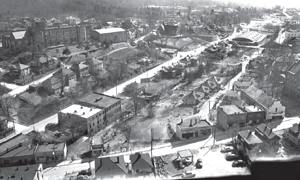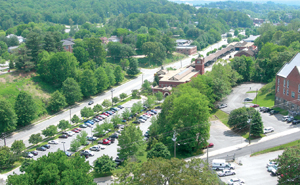



Feature Story
More feature stories by year:
2024
2023
2022
2021
2020
2019
2018
2017
2016
2015
2014
2013
2012
2011
2010
2009
2008
2007
2006
2005
2004
2003
2002
2001
2000
1999
1998
Return to: 2009 Feature Stories
CLIENT: MACTEC, Inc.
September 2009 : Public Works Online
Sustainability and stimulus spark renewed interest in old industrial property.
As the least-polluted sites were harvested, so to speak, and greenfield financing became easier to obtain, the average time frame for redeveloping a brownfield stretched from three to five years. But the American Recovery and Reinvestment Act of 2009 significantly boosted the amount of funding available for the U.S. EPA's Brownfields Program from $86.8 million to $186.8 million and brownfields are becoming the new green.
Urban commercial and mixed-use redevelopment provides more tax revenue with lower service costs than low-density suburban residential development. In 2008, the U.S. Conference of Mayors estimated that property formerly inhabited by textile and steel mills, chemical and electronic-component manufacturing plants, and tanneries consume 83,949 acres of land nationwide for an average site size of 6.5 acres.
More than 150 cities that responded to the organization's survey had redeveloped 1,578 sites, raising $408 million in new tax revenues for 62 cities and creating 187,000 jobs in 75 cities.
Though the stimulus package didn't change or waive criteria for brownfield grants or loans, managers looking to relocate headquarters can follow the lead set by Asheville, N.C. In the 1970s, the city used at least two aspects of the Housing and Community Development Act of 1974 the newly created Community Development Block Grant and updated Section 8 programs to build a new public works complex.
WORKING WITH FEDERAL CRITERIA
Beginning about 1850 and ending after World War II, plants in and around the city converted coal, coke, and oil to gas for lighting, cooking, and heating. The city prospered, but the process produced hazardous byproducts that take decades to naturally degrade.
The department's leased facility was built in the 1920s on land formerly occupied by one such plant. Due to its central location just 500 yards from city hall the city decided to buy the property, demolish the old facility, and buy adjacent underutilized or vacant property as part of a comprehensive urban renewal program that included a new public works complex.

The city received millions in federal funding through the revised housing act as well as "model cities" funding through the Demonstration Cities and Metropolitan Development Act of 1966. It developed a targeted plan for removing vacant buildings, and held a referendum for public approval. It was the largest initiative of its kind in the southeast and, though initially resisted by the community, was ultimately approved.
Existing water and sewer lines usually can handle a redevelopment's needs, but private developers can be required to upgrade service to provide additional capacity. In Asheville's case, infrastructure improvements included widening and removing roadways, upgrading water and sewer service in the area, and enclosing a stream.
Remediation strategies are tailored to the specific environmental conditions of each site, but commonly include excavating grossly contaminated soils, installing active or passive venting systems, and building physical barriers to prevent contact with contaminated environmental media. The area of the former gas plant was "capped" with concrete and asphalt pavement to keep rainwater from filtering through potentially contaminated soil.
Because fleet garages are often open-air type shelters and include large paved parking and access areas, they're well-suited to incorporating risk-based remediation strategies that are the backbone of brownfields agreements. Thus, the department's new complex includes a 24,000-square-foot fleet management building.
Today, Public Works Director Mark Combs coordinates access for environmental sampling and completes an annual certification to document that deed restrictions are being followed, a process that takes about four hours. Because of a state-regulated manufactured gas plant assessment program funded by utilities in the early 2000s, he helped prepare a "snapshot" of site conditions. Between 2003 and 2006, he spent 20 hours on conference calls with an environmental consultant paid by the utility that had owned the plant, consulting with the city attorney, coordinating access for sampling, and reviewing reports.
When the entity that caused contamination can't be identified, site assessment sampling and laboratory analysis of soil and water, documenting properties in the area that could be impacted by the contamination, and evaluating potential for vapor intrusion and remediation costs are the responsibility of the agency or company that wants to redevelop the site.
Meanwhile, the private sector is jumping on the brownfield bandwagon in Asheville.
In April, BD90 LLC announced it will redevelop 13 acres that had housed the nation's largest tannery of its kind for mixed commercial-residential use.
The firm's $30,000 EPA assessment grant funding was provided through the Land-of-Sky Regional Council serving North Carolina's Buncombe, Henderson, Madison, and Transylvania counties. The EPA's also helping fund a national competition in which college students create an environmentally friendly, sustainable, mixed-use development design that incorporates innovative building techniques, LEED certification, and low-impact development methods. (Visit www.RecycleThisSite.org.)
THE BASICS OF BROWNFIELDS
To help overcome environmental regulatory obstacles in the redevelopment of brownfield sites, states designated with brownfield program authority through the EPA provide liability relief in the format of brownfield agreements based on individual site contamination evaluations and intended reuse.

These are before-and-after views of 14 acres formerly containing a manufactured gas plant (upper right in the black-and-white photo) and now home to a public works complex dubbed the Taj MahGarage by Asheville, N.C., residents. From the 1970s through the 1990s, the city built six buildings totaling 90,000 square feet. A creek runs parallel to the street from lower left to upper right.
Liability relief comes in the form of a covenant "not-to-sue," which is intended to reduce barriers to obtaining financing. Eligibility criteria for enrollment in a brownfield program varies from state to state, but usually requires an identified developer with a redevelopment plan or project versus buy-and-resell, job creation, and perceived economic benefit for the community.
Once an agreement between the state and the developer is executed, there are ongoing requirements for compliance.
Typically, annual certifications must be completed by the property owner stating that the engineering or administrative controls passive or active barriers to contaminant exposure, restrictions on groundwater use, etc. placed on the property via a deed restriction continue to be used as documented in the agreement to protect the property user from the contamination.
Given the emphasis on reusing existing resources as much as possible, a public works operation can generate goodwill by converting a community eyesore into a facility that everyone can be proud of.
Return to: 2009 Feature Stories